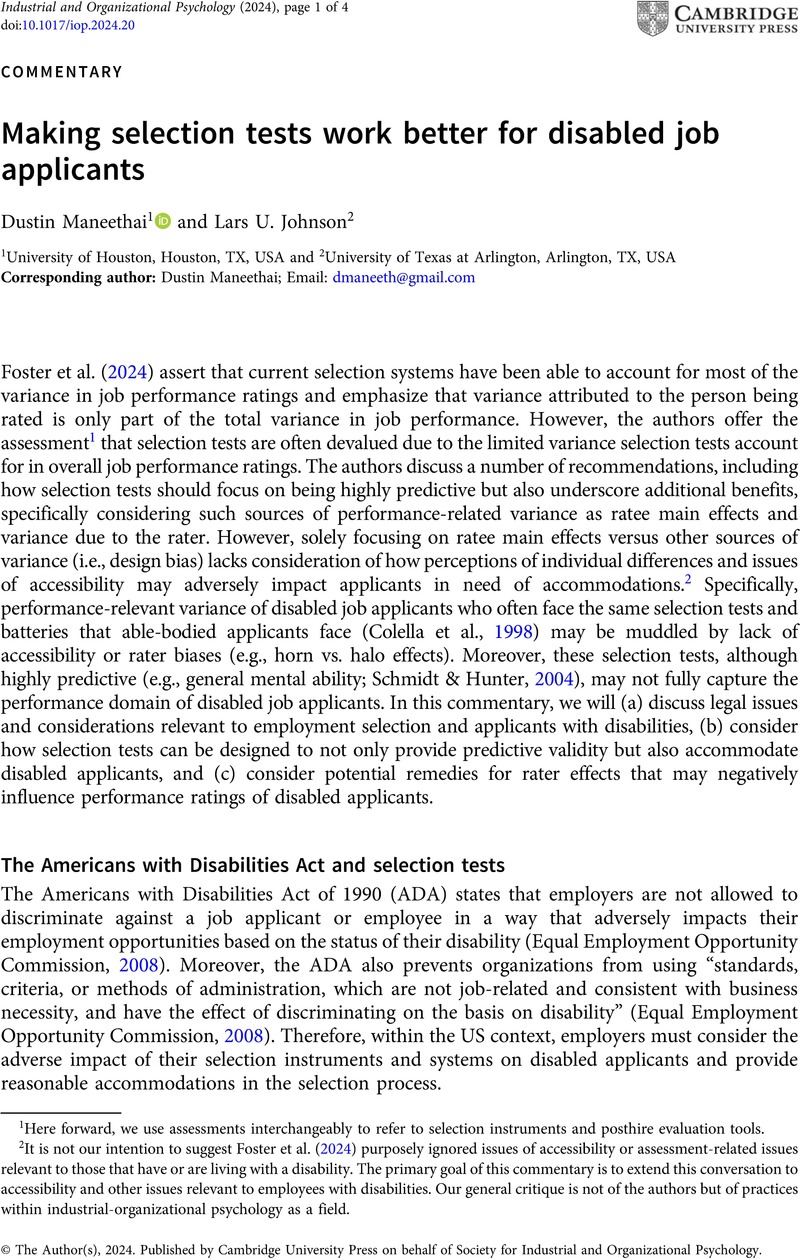No CrossRef data available.
Article contents
Making selection tests work better for disabled job applicants
Published online by Cambridge University Press: 29 August 2024
Abstract
An abstract is not available for this content so a preview has been provided. Please use the Get access link above for information on how to access this content.

- Type
- Commentaries
- Information
- Copyright
- © The Author(s), 2024. Published by Cambridge University Press on behalf of Society for Industrial and Organizational Psychology
References
Arthur, W., Edwards, B. D., & Barrett, G. V. (2002). Multiple-choice and constructed response tests of ability: Race-based subgroup performance differences on alternative paper-and-pencil test formats. Personnel Psychology, 55(4), 985–1008. https://doi.org/10.1111/j.1744-6570.2002.tb00138.x
CrossRefGoogle Scholar
Campion, M. A., & Campion, E. D. (2023). Machine learning applications to personnel selection: Current illustrations, lessons learned, and future research. Personnel Psychology, 76(4), 993–1009. https://doi.org/10.1111/peps.12621
CrossRefGoogle Scholar
Colella, A., DeNisi, A. S., & Varma, A. (1998). The impact of ratee’s disability on performance judgments and choice as partner: The role of disability-job fit stereotypes and interdependence of rewards. Journal of Applied Psychology, 83(1), 102–111. https://doi.org/10.1037/0021-9010.83.1.102
CrossRefGoogle ScholarPubMed
Equal Employment Opportunity Commission (2008). Applying performance and conduct standards to employees with disabilities. EEOC. https://www.eeoc.gov/laws/guidance/applying-performance-and-conduct-standards-employees-disabilities.Google Scholar
Foster, J., Steel, P., Harms, P., O’Neill, T., & Wood, D. (2024). Selection tests work better than we think they do, and have for years. Industrial and Organizational Psychology, 17, 1–32.Google Scholar
Gutman, A. (2015). Disabilities: Best practices for vulnerabilities associated with the ADA. In Hanvey, C., & Sady, K. (Ed.), Practitioner’s guide to legal issues in organizations (pp. 163–182). Springer International Publishing. https://doi.org/10.1007/978-3-319-11143-8_7
CrossRefGoogle Scholar
Hazer, J. T., & Bedell, K. V. (2000). Effects of seeking accommodation and disability on preemployment evaluations. Journal of Applied Social Psychology, 30(6), 1201–1223. https://doi.org/10.1111/j.1559-1816.2000.tb02517.x
CrossRefGoogle Scholar
Hebl, M. R., & Skorinko, J. L. (2005). Acknowledging one’s physical disability in the interview: Does “When” make a difference? Journal of Applied Social Psychology, 35(12), 2477–2492. https://doi.org/10.1111/j.1559-1816.2005.tb02111.x
CrossRefGoogle Scholar
Leasher, M. K., Miller, C. E., & Gooden, M. P. (2009). Rater effects and attitudinal barriers affecting people with disabilities in personnel selection. Journal of Applied Social Psychology, 39(9), 2236–2274. https://doi.org/10.1111/j.1559-1816.2009.00523.x
CrossRefGoogle Scholar
Levashina, J., Hartwell, C. J., Morgeson, F. P., & Campion, M. A. (2014). The structured employment interview: Narrative and quantitative review of the research literature. Personnel Psychology, 67(1), 241–293. https://doi.org/10.1111/peps.12052
CrossRefGoogle Scholar
Lievens, F., & Sackett, P. R. (2017). The effects of predictor method factors on selection outcomes: A modular approach to personnel selection procedures. Journal of Applied Psychology, 102(1), 43–66. https://doi.org/10.1037/apl0000160
CrossRefGoogle ScholarPubMed
Lyons, B. J., Martinez, L. R., Ruggs, E. N., Hebl, M. R., Ryan, A. M., O’Brien, K. R., & Roebuck, A. (2018). To say or not to say: Different strategies of acknowledging a visible disability. Journal of Management, 44(5), 1980–2007. https://doi.org/10.1177/0149206316638160
CrossRefGoogle Scholar
Moss, H. (2021). Screened out onscreen: Disability discrimination, hiring bias, and artificial intelligence. Denver Law Review. https://doi.org/10.2139/ssrn.3906300
Google Scholar
Premeaux, S. F. (2001). Impact of applicant disability on selection: The role of disability type, physical attractiveness, and proximity. Journal of Business and Psychology, 16(2), 291–298. https://doi.org/10.1023/A:1011117402209
CrossRefGoogle Scholar
Sackett, P. R., & Lievens, F. (2008). Personnel selection. Annual Review of Psychology, 59(1), 419–450. https://doi.org/10.1146/annurev.psych.59.103006.093716
CrossRefGoogle ScholarPubMed
Schmidt, F. L., & Hunter, J. (2004). General mental ability in the world of work: Occupational attainment and job performance. Journal of Personality and Social Psychology, 86(1), 162–173. https://doi.org/10.1037/0022-3514.86.1.162
CrossRefGoogle ScholarPubMed
Van Iddekinge, C. H., Raymark, P. H., & Roth, P. L. (2005). Assessing personality with a structured employment interview: Construct-related validity and susceptibility to response inflation. Journal of Applied Psychology, 90(3), 536–552. https://doi.org/10.1037/0021-9010.90.3.536
CrossRefGoogle ScholarPubMed




